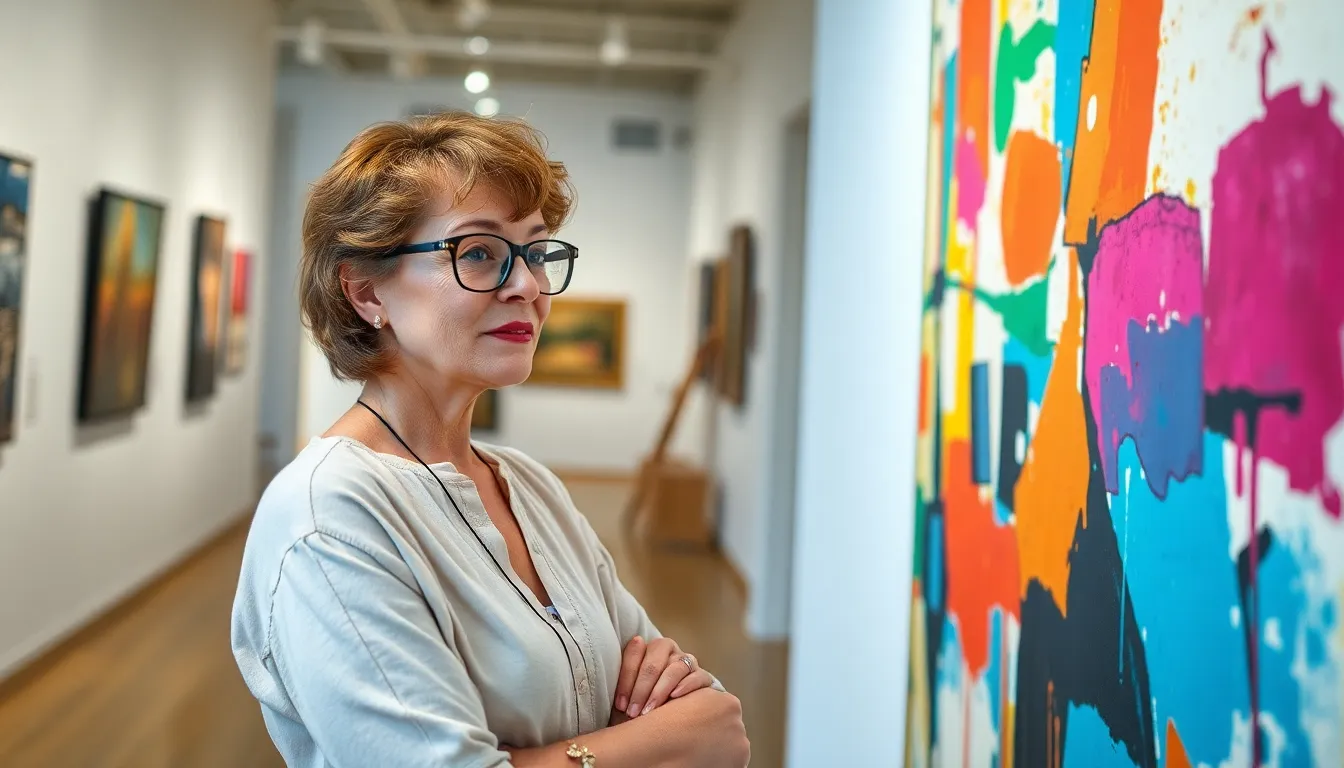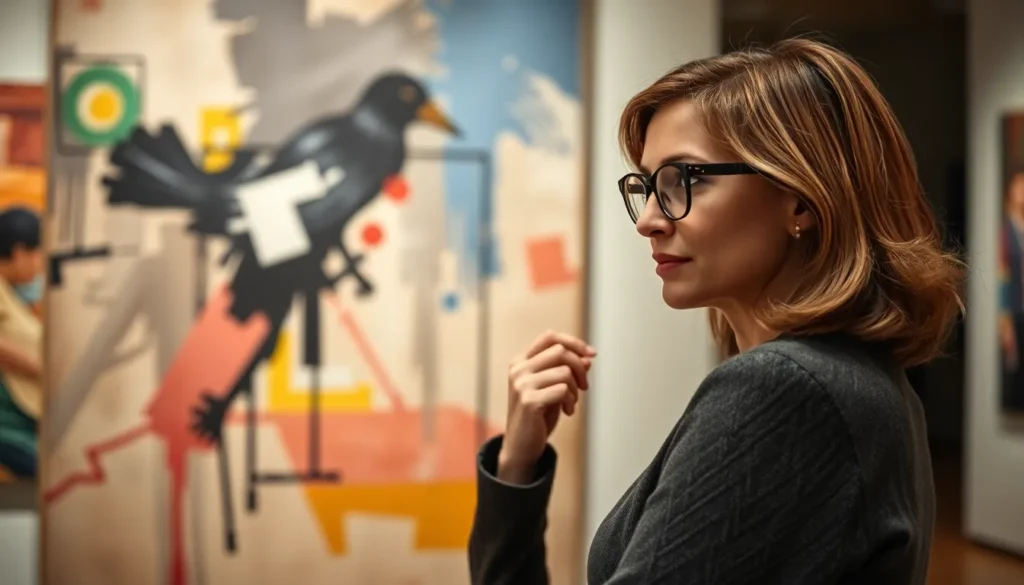Table of Contents
ToggleArt isn’t just paint on canvas or a sculpture in a park; it’s a conversation waiting to happen. Every brushstroke and chisel mark tells a story, and diving into a critical analysis of art reveals layers of meaning that might just blow your mind. Whether you’re a seasoned art lover or someone who thinks a masterpiece is a finger painting from kindergarten, understanding the intricacies of art can transform the way you see the world.
Imagine walking through a gallery and feeling like a detective unraveling secrets hidden in plain sight. From the emotions behind a piece to the historical context that shaped it, critical analysis invites everyone to engage in this delightful dialogue. So grab your magnifying glass and let’s embark on a journey that’ll make even the most perplexing artwork seem like a playful riddle waiting to be solved.
Understanding Critical Analysis of Art
Critical analysis of art involves examining artworks to reveal their underlying messages and values. This process allows individuals to appreciate art on a deeper level, empowering them to engage thoughtfully with their surroundings.
Definition and Importance
Critical analysis refers to an in-depth evaluation of art, focusing on elements like form, context, and technique. This method encourages viewers to move beyond surface impressions and consider the cultural influences, historical background, and emotional resonance within the piece. Engaging in critical analysis enriches the viewer’s experience, fostering a more informed and meaningful understanding of art’s role in society.
Key Components of Analysis
Several key components underpin effective critical analysis of art. First, observation involves assessing the visual aspects such as color, composition, and texture. Next, context plays a significant role; understanding the historical and cultural background adds depth to interpretations. Additionally, interpretation relies on personal insights and emotional responses, allowing a connection to emerge between the viewer and the artwork. Lastly, evaluation helps discern the overall impact, encouraging insightful discussions about implications and significance. Each component intertwines, guiding a thorough exploration of artistic expression.
Methods of Critical Analysis

Critical analysis incorporates various methods that enhance understanding of art. Two significant methods include visual analysis and contextual analysis.
Visual Analysis
Visual analysis focuses on the artwork’s elements such as color, line, shape, and texture. Observers analyze how these elements work together to create mood and meaning. Shapes can direct the viewer’s eye and influence emotional responses. Color choices often evoke specific feelings and associations. The arrangement of these visual components establishes emphasis and harmony. Attention to detail reveals nuances that contribute to the overall experience. Through visual analysis, individuals uncover layers of meaning that may not be immediately evident, allowing for a richer appreciation of the artwork.
Contextual Analysis
Contextual analysis places the artwork within its historical and cultural framework. Examining the artist’s background and influences provides deeper insights. Societal, political, and personal circumstances often shape the creation process. Recognizing these factors helps viewers grasp the significance of themes and messages. The surrounding environment can also impact the interpretation of the piece. Contextual elements might include the time period and prevailing artistic movements. Engaging with this analysis enriches one’s understanding and fosters a more profound connection to the artwork, revealing how art interacts with the world.
The Role of Interpretation
Interpretation plays a vital role in the critical analysis of art. It allows viewers to engage with artworks beyond the superficial level, fostering personal connections and nuanced understandings.
Subjectivity in Art Criticism
Subjectivity characterizes art criticism, as individual perspectives influence interpretations. Each person’s background, experience, and emotional response shape how they perceive an artwork. For instance, two viewers may derive entirely different meanings from the same piece. This variability highlights the personal nature of art appreciation. Exposure to diverse viewpoints enriches discussions, encouraging an open-minded approach to analysis. Recognizing that interpretations can differ fosters a deeper appreciation for artistic expression. Art’s fluid nature invites multiple interpretations, allowing each viewer to find unique connections that resonate.
Influence of Historical Context
Historical context significantly influences the interpretation of art. Understanding the time period and cultural circumstances surrounding a piece deepens the comprehension of its meaning. Artists often reflect societal norms, values, and challenges in their work. Familiarity with major historical events, movements, or trends can illuminate the artist’s intentions and the artwork’s message. For example, knowing the impact of World War II on artists can enhance appreciation for modernist art that emerged during that era. Contextual knowledge anchors art in its time, revealing the interplay between art and society. By exploring these connections, viewers grasp the broader implications and significance of artistic works.
Case Studies in Critical Analysis
Analyzing specific artworks provides insight into critical analysis in practice. The following examples illustrate approaches to modern and classical art.
Modern Art Examples
Modern art challenges traditional perspectives, encouraging varied interpretations. Jackson Pollock’s “No. 5, 1948” exemplifies abstract expressionism through its chaotic drips and splatters. This technique evokes emotion beyond visual aesthetics. Many viewers interpret the energy of the piece in unique ways, reflecting personal experiences. Another noteworthy example is Andy Warhol’s “Marilyn Diptych,” which comments on celebrity culture. The repetitive use of Marilyn Monroe’s image prompts discussions about commercialization in art and society. Each analysis of these modern works reveals layers of interpretation and societal commentary, enriching viewers’ understanding.
Classical Art Examples
Classical art offers timeless insights into historical contexts and human emotion. Leonardo da Vinci’s “Mona Lisa” captivates audiences with her enigmatic smile and meticulous detail. Scholars often debate her expression, suggesting various emotional states and meanings. Another significant piece, Michelangelo’s “David,” captures the idealized human form and the essence of Renaissance values. This sculpture embodies the tension between physicality and intellect, symbolizing both artistic mastery and philosophical ideals. Critical analysis of these classical works enhances appreciation of their cultural significance, illustrating the relationship between art, history, and humanity.
Engaging in critical analysis of art opens up a world of discovery and understanding. By examining the various components of an artwork and considering its context, individuals can unlock deeper meanings that resonate on both personal and societal levels. This journey not only enhances appreciation for the artwork itself but also fosters a greater connection to the surrounding world.
Art becomes more than just a visual experience; it transforms into a dialogue that invites interpretation and discussion. As viewers embrace the complexities of art, they enrich their own perspectives and contribute to a broader conversation about culture and humanity. Ultimately, critical analysis cultivates a more profound relationship with art, empowering individuals to see beyond the surface and appreciate the intricate layers of meaning woven into each piece.



